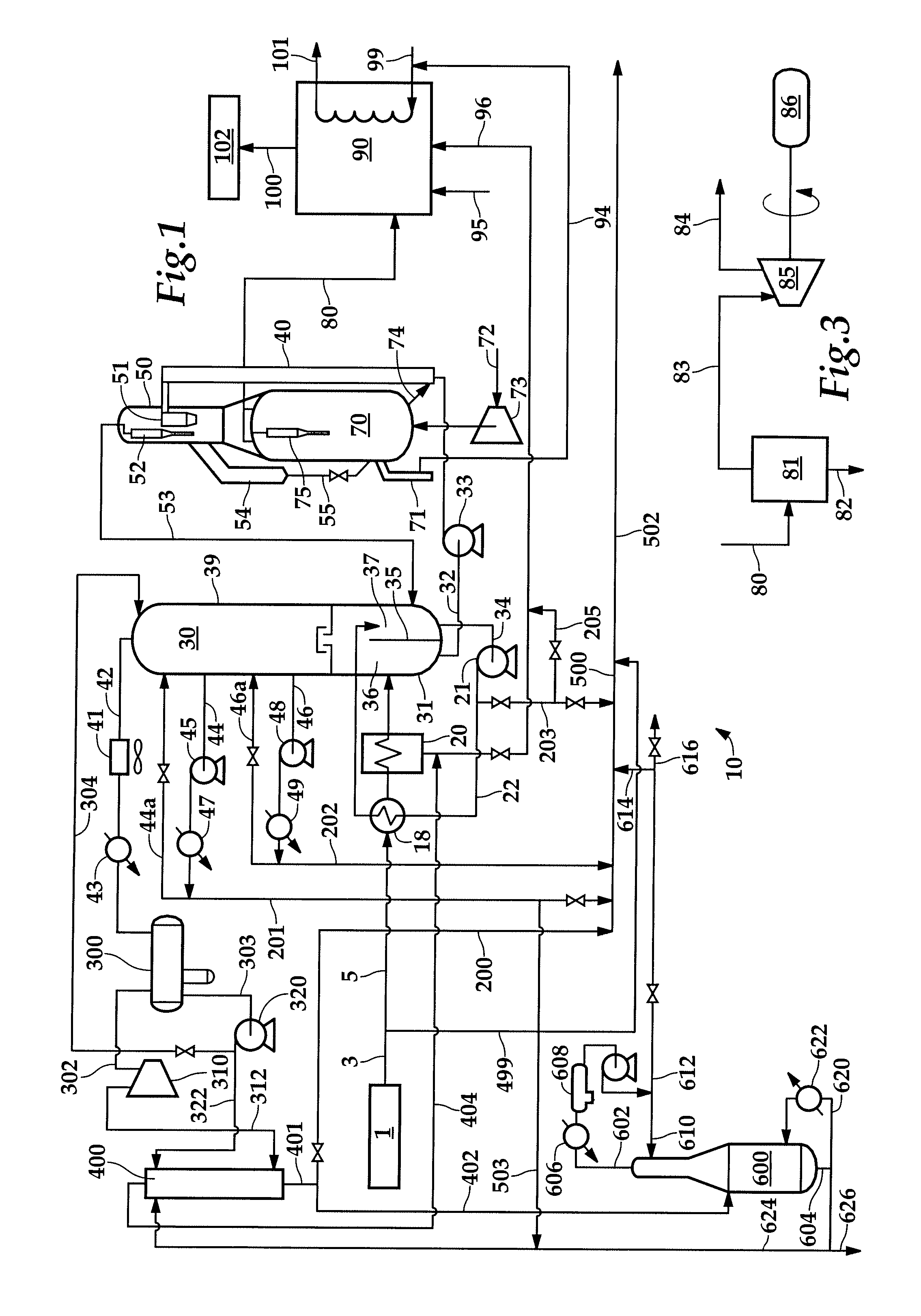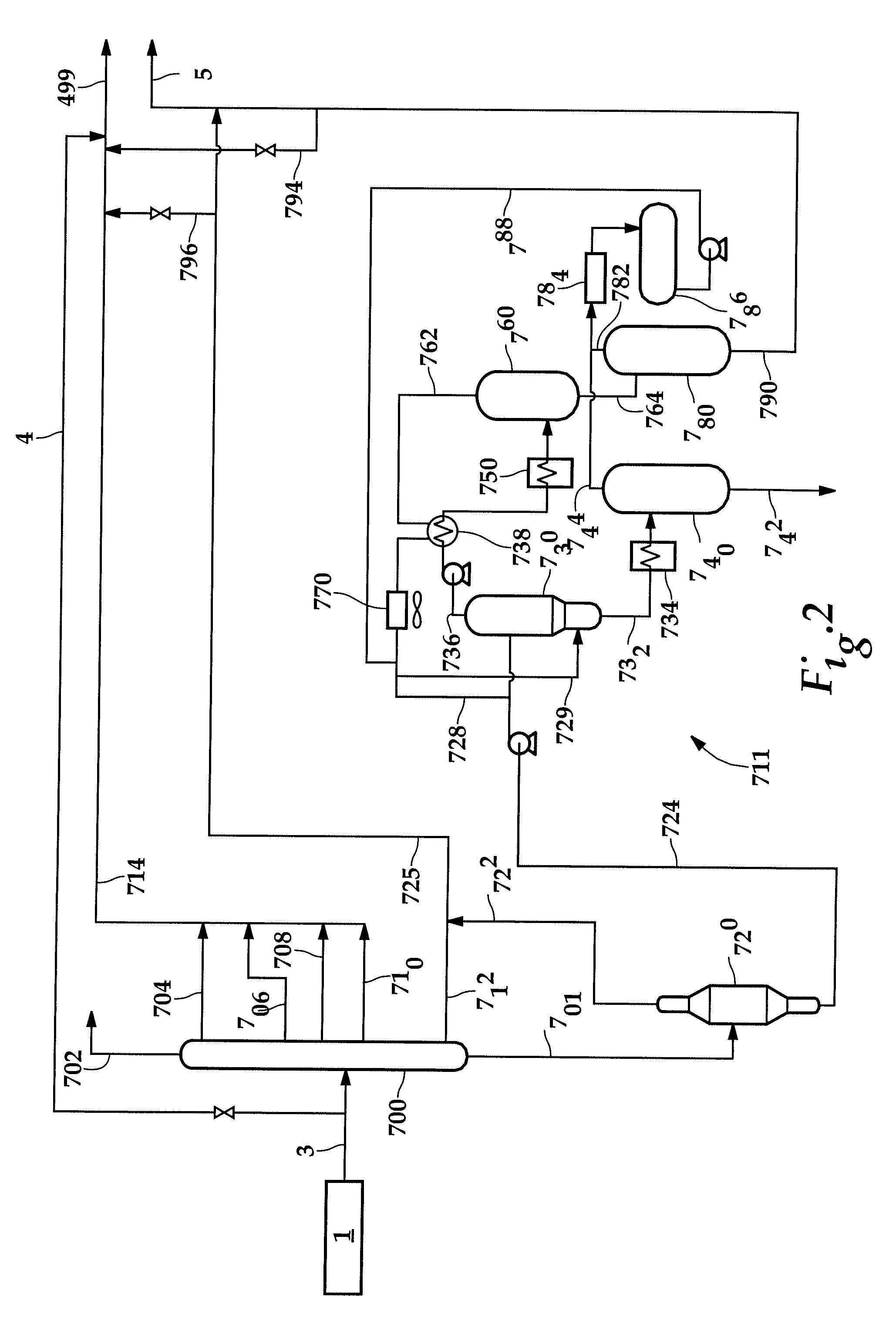Process and apparatus for improving flow properties of crude petroleum
a technology of crude petroleum and flow properties, applied in the field of new products, can solve the problems of high boiling point, large amount of wax, and high cost, and achieve the effect of improving the flow properties of crude petroleum products
- Summary
- Abstract
- Description
- Claims
- Application Information
AI Technical Summary
Benefits of technology
Problems solved by technology
Method used
Image
Examples
example 1
[0074] In this example, crude oil from characterized in Table 1 is divided into a feed stream comprising about 30 wt-% of the crude oil.
TABLE 1Sample Crude (from Colombia)API gravity12.8UOP K11.40Nickel, wt-ppm42Vanadium, wt-ppm152Sulfur, wt-%1.28Con-Carbon, wt-%12.88
[0075] The sample crude feed in Table 1 was subjected to FCC processing to obtain a product with the composition in Table 2. The composition in Table 2 is based on a recovery of 89 wt-% of C4's and 66 wt-% recovery of C3's for remixing with the bypass crude.
TABLE 2Estimated Conditions for the FCC UnitProductsFeed Rate, BPSD15,000Riser Temperature, ° F. (° C.)450 (232)Reactor Temperature, ° F. (° C.)975 (524)Reactor Pressure, psig20 Catalyst MAT64 Catalyst / Oil, lb / lb feed10.09Delta Coke, wt % 1.50Regenerator Temperature, ° F. (° C.)1228 (664) Conversion, vol-% (90% @ 380° F. (193° C.)66.6 Liquid Recovery, vol-%99.12Mix API 39.7 **Mix RVP @ 100° F. (38° C.) 28.9 **
[0076] The FCC product of Table 2 was mixed with the...
example 2
[0077] In this example, the feed to the process is bitumen having API gravity of 10.2. All of the bitumen is subjected to a solvent-deasphalting step. The pitch created from the deasphalting step may then be burned in a CO boiler. For purposes of comparison, the pipeline specification will be assumed to require a specific gravity of at least 19 API and a viscosity of no more than 120 cSt at 77° F. (25° C.). Table 4 gives properties for the product of FCC processing of bitumen.
TABLE 4FCC Products for Bitumen-containing Crude FeedWt-%APILV-%C5+ naphtha 380° F. / 90% (193° C. / 90%)44.7252.6856.18LCO (600 F. ° / 90%)17.2414.7317.19Bottoms at 650° F. (343° C.)14.132.7112.93C3 + C411.54Total87.63
[0078] Table 5 shows properties of the components of the diluent and the whole bitumen.
TABLE 5FCC Products for Bitumen-containing Crude FeedViscositycSt @cSt @cSt @Fraction ofSpecific122° F.210° F.77° F.R Refutas VBNDiluent,Gravity,UOP K(50° C.)(99° C.)(25° C.)@77° F. (25° C.)wt-%g / ccWhole600015010...
example 3
[0081] In this example, 207,670 BPD of Canadian Cold Lake Bitumen having an API gravity of 10.6 is fractionated and the 1050° F.+ vacuum bottoms is fed to a solvent deasphalting process, rejecting a stream of 35,100 BPD of pitch having a gravity of −10 API. 66,460 BPD of the deasphalted oil is sent to an FCC unit and the products boiling below pentane are separated for fuel or sales. The deasphalted bitumen is combined with the blended FCC products to form a synthetic crude oil. The pitch rejected from the process is burned as auxiliary fuel in the CO boiler which generates the required steam for the recovery of bitumen from the ground by the steam-assisted gravity drainage (SAGD) process. The steam / oil weight ratio of the bitumen extraction process is assumed to be 3.0 which is equal to a 20% margin over the reported target value of 2.5 for a 1 5 commercial process as operated by the EnCana Corporation at their operations in either Christina Lake or Foster Creek, Alberta according ...
PUM
 Login to View More
Login to View More Abstract
Description
Claims
Application Information
 Login to View More
Login to View More - R&D
- Intellectual Property
- Life Sciences
- Materials
- Tech Scout
- Unparalleled Data Quality
- Higher Quality Content
- 60% Fewer Hallucinations
Browse by: Latest US Patents, China's latest patents, Technical Efficacy Thesaurus, Application Domain, Technology Topic, Popular Technical Reports.
© 2025 PatSnap. All rights reserved.Legal|Privacy policy|Modern Slavery Act Transparency Statement|Sitemap|About US| Contact US: help@patsnap.com



